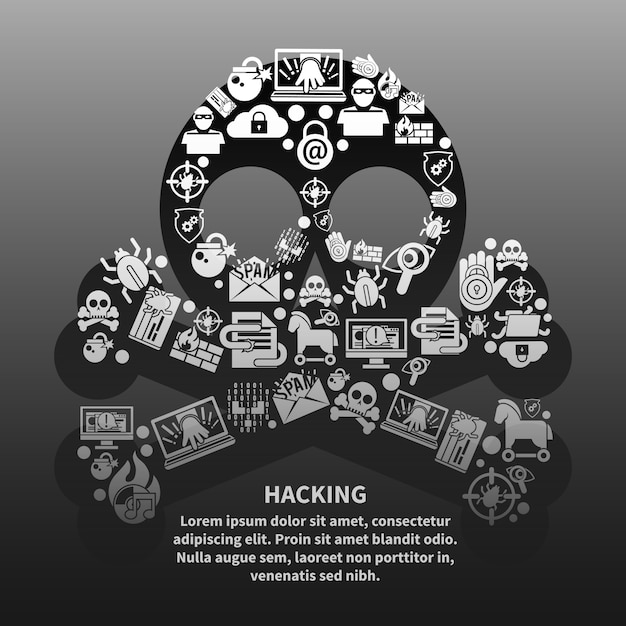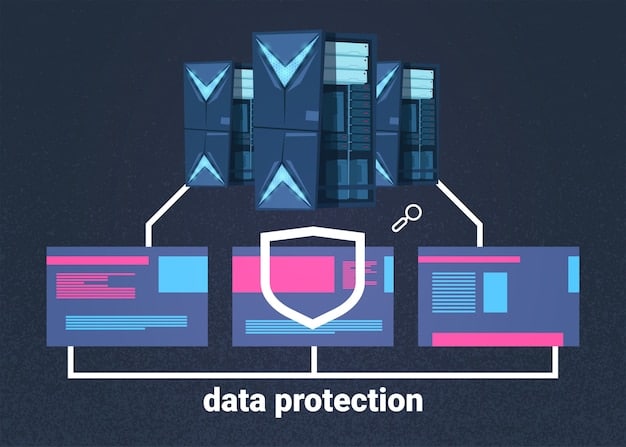Analyzing Cybersecurity Threats Impact on US Businesses: Risk Mitigation Strategies

Analyzing the Impact of Global Cybersecurity Threats on US Businesses: Strategies for Risk Mitigation involves understanding the escalating risks, economic consequences, and proactive measures U.S. businesses can implement to safeguard their assets and maintain operational integrity.
In today’s interconnected world, analyzing the impact of global cybersecurity threats on US businesses: strategies for risk mitigation is no longer optional but a critical necessity for survival in the digital age, as businesses face an increasing number of sophisticated cyberattacks that can cripple operations and erode consumer trust.
Understanding the Landscape of Cybersecurity Threats
To begin mitigating cybersecurity risks effectively, U.S. businesses must first comprehend the evolving threat landscape. This involves identifying the prevalent types of cyber threats and understanding how they target vulnerabilities within the business’s infrastructure.
Common Types of Cyber Threats
Various types of cyber threats pose a risk to businesses in the U.S., each with its distinct characteristics and methods of operation. Recognizing these threats is the first step in building a robust defense.
- Ransomware: A type of malware that encrypts a victim’s files, rendering them inaccessible until a ransom is paid.
- Phishing: A deceptive technique used to trick individuals into revealing sensitive information, such as usernames, passwords, and credit card details, by disguising as a trustworthy entity.
- Malware: Malicious software designed to disrupt, damage, or gain unauthorized access to a computer system.
Each of these cyber threats demands specific countermeasures and vigilant defenses to protect U.S. businesses and their assets.
The Economic Impact of Cyberattacks
The economic impact of cyberattacks on US businesses can be devastating. Along with immediate financial losses, businesses may suffer from reputational damage and decreased customer trust.
- Financial Losses: The immediate costs associated with repairing damaged systems, paying ransoms, regulatory fees, and legal settlements can be substantial.
- Reputational Damage: A successful data breach can undermine customer confidence, leading to a loss of business and long-term damage to a company’s reputation.
- Operational Disruptions: Cyberattacks can halt operations, leading to loss of productivity and revenue.
Understanding the far-reaching effects of cyberattacks helps businesses prioritize cybersecurity investments and risk mitigation strategies.
By identifying the types of cyber threats and assessing their potential economic impact, U.S. businesses can better prepare and protect themselves against these evolving risks.
Assessing Vulnerabilities in Your Business Infrastructure
A key part of analyzing the impact of global cybersecurity threats on US businesses: strategies for risk mitigation involves finding vulnerabilities in your business infrastructure. Regular assessments help identify weak spots that cybercriminals might exploit.

Conducting Regular Risk Assessments
To thoroughly protect your business, set up regular risk assessments. Take steps to identify vulnerabilities and assess the possible effects of cyberattacks.
- Identify Critical Assets: Determine which assets, such as sensitive data, intellectual property, and critical systems, are most valuable to your business.
- Assess Potential Threats: Investigate the types of cyber threats that are most likely to target your business, based on your industry and geographic location.
- Evaluate Existing Controls: Assess the effectiveness of your existing security measures, such as firewalls, intrusion detection systems, and antivirus software.
Carry out risk evaluations often to effectively handle growing dangers and guarantee your preventative actions continue to be helpful.
Common Vulnerabilities to Watch Out For
Businesses must watch out for everyday vulnerabilities that could be exploited by cybercriminals. Addressing these weaknesses reduces the risk of successful attacks.
- Outdated Software: Ensure all software, including operating systems, applications, and security tools, is up to date with the latest patches and updates.
- Weak Passwords: Enforce strong password policies that require complex passwords and regular password changes. Implement multi-factor authentication (MFA) for critical systems.
- Unprotected Entry Points: Secure all entry points to your network, including remote access points, wireless networks, and cloud services.
By conducting regular risk assessments and addressing common vulnerabilities, U.S. businesses can significantly strengthen their security posture.
Conducting risk assessments and identifying vulnerabilities in the IT infrastructure are key steps in protecting against cyberattacks. Regularly updating security measures makes the business stronger and more resilient.
Implementing Proactive Cybersecurity Measures
Implementing proactive cybersecurity measures is essential for US businesses to defend successfully against modern cyber threats. This involves deploying a mix of technologies and protocols to prevent, detect, and respond to security incidents.

Deploying Advanced Security Technologies
U.S. businesses should deploy advanced security technologies to enhance their defenses against cyber threats. These technologies can help automatically detect and respond to security incidents.
- Endpoint Detection and Response (EDR): This system monitors endpoints for malicious activity, allowing you to promptly identify and respond to threats that bypass traditional security measures.
- Security Information and Event Management (SIEM): Centralizes security logs and events from across your IT infrastructure, providing real-time threat detection and incident response capabilities.
- Intrusion Detection and Prevention Systems (IDPS): Analyzes network traffic for malicious activity and automatically blocks or prevents intrusions.
Such systems enhance the safety and resilience of organizations against cyber intrusions and guarantee early warning of prospective risks.
Employee Training and Awareness Programs
Educating and training employees about cybersecurity best practices is vital for strengthening your security posture. Well-informed employees are less likely to fall victim to phishing attacks and social engineering tactics.
- Phishing Simulations: Conducting regular phishing simulations helps employees recognize and avoid malicious emails.
- Security Awareness Training: Provide regular training sessions covering topics such as password security, data handling, and safe internet browsing practices.
- Incident Reporting: Encourage employees to report suspicious activity promptly, and establish a clear process for reporting security incidents.
Training programs help organizations create a security-conscious culture, ensuring every employee is engaged in protecting sensitive information.
Deploying advanced security technologies with employee training and awareness initiatives strengthens U.S. businesses against cyber threats. Proactive steps build flexibility and safeguard important assets when prevention is inadequate.
Developing a Comprehensive Incident Response Plan
A comprehensive incident response plan is essential for US businesses to reduce the damage from cybersecurity incidents. This strategy spells out the actions to take in the event of a cybersecurity breach.
Key Components of an Incident Response Plan
An effective incident response plan should include several key components that guide the response process and minimize the impact of a security breach.
- Incident Identification: Define the criteria for identifying a security incident, and establish procedures for reporting and confirming security breaches.
- Containment Strategy: Develop strategies for containing the incident to prevent further damage, such as isolating affected systems and networks.
- Eradication and Recovery: Outline steps for removing the threat, restoring affected systems and data, and verifying their integrity.
Having these components in place ensures a swift and coordinated response to security incidents.
Testing and Updating Your Response Plan
Routinely testing and updating your incident response plan helps ensure its effectiveness. Regular testing identifies weaknesses in the plan and provides opportunities for improvement.
- Tabletop Exercises: Conduct simulation exercises to walk through different incident scenarios and assess the readiness of your response team.
- Regular Updates: Update the plan regularly to reflect changes in your business environment, technology landscape, and threat environment.
- Feedback Incorporation: Incorporate feedback from incident response exercises and real-world incidents to improve the plan.
Testing also helps team members become more familiar with their roles and responsibilities during an incident.
Developing and maintaining a comprehensive incident response plan ensures that U.S. businesses can quickly and effectively respond to security incidents. Regular testing and updates enhance the plan’s performance, improving overall security.
The Role of Cyber Insurance in Risk Mitigation
Cyber insurance plays an important role in analyzing the impact of global cybersecurity threats on US businesses: strategies for risk mitigation, offering financial protection against losses resulting from cyberattacks and data breaches.
Understanding Cyber Insurance Policies
US businesses should understand the different types of cyber insurance policies available and their coverage terms. These policies can provide coverage for various expenses associated with security incidents.
- Data Breach Coverage: Covers expenses related to notifying affected customers, providing credit monitoring services, and managing public relations.
- Cyber Extortion Coverage: Covers ransom payments, negotiation expenses, and related costs associated with ransomware attacks.
- Business Interruption Coverage: Compensates for lost income and expenses resulting from business disruptions caused by cyberattacks.
A thorough understanding of these policies helps businesses choose the optimal insurance package for mitigating possible risks.
Benefits and Limitations of Cyber Insurance
While cyber insurance can provide financial protection, U.S. businesses should be aware of its benefits and limitations. Cyber insurance can supplement other risk mitigation strategies, but it should not be a substitute for robust security measures.
- Financial Protection: Cyber insurance can help cover the costs associated with security incidents, reducing the financial impact on your business.
- Risk Transfer: Cyber insurance transfers some of the financial risk associated with cyberattacks to an insurance provider.
- Policy Limitations: Cyber insurance policies may have exclusions, limitations, and deductibles that can affect coverage.
Organizations must carefully evaluate policies to ensure they align with their security requirements and overall strategic goals.
Cyber insurance is an important layer in the risk mitigation of U.S. businesses, offering financial protection against losses from cyberattacks. Knowing the policies and their constraints helps firms make educated decisions on securing IT assets completely.
Staying Ahead of Emerging Cybersecurity Threats
To stay competitive in the digital era, U.S. businesses must stay ahead of emerging cybersecurity threats. This involves continuous education, monitoring, and adaptation to new dangers.
Monitoring the Threat Landscape
Regularly monitoring the threat landscape enables U.S. businesses to identify new and emerging cyber threats. Staying informed about threat trends helps businesses proactively adjust their security measures.
- Threat Intelligence Feeds: Subscribe to threat intelligence feeds to receive real-time information about emerging threats, vulnerabilities, and attack techniques.
- Industry Forums: Participate in industry forums to exchange information and best practices with peers.
- Security Blogs and Newsletters: Follow security blogs and newsletters to stay informed about the latest security threats and trends.
Regularly scan network activity to immediately discover dubious behavior or prospective indications of intrusions.
Adaptation and Continuous Improvement of Security Measures
U.S. businesses should continuously adapt and improve their security measures to address emerging threats and vulnerabilities. Taking a proactive approach to security enhances the organizations’ long-term resilience against cyberattacks.
- Regular Security Audits: Conduct regular security audits to assess the effectiveness of your security measures and identify areas for improvement.
- Vulnerability Management: Implement a vulnerability management program to identify and remediate vulnerabilities in a timely manner.
- Incident Response Plan Updates: Update your incident response plan regularly to reflect changes in the threat environment and your business operations.
Assessing and increasing security measures constantly offers U.S. firms the elasticity to face fresh concerns and maintain proper operations.
Staying updated on emerging cybersecurity threats and improving security measures ensures that U.S. businesses are better prepared to defend against evolving dangers. Flexible preparations are thus crucial as a means to improve an organization’s endurance.
| Key Point | Brief Description |
|---|---|
| 🛡️ Risk Assessments | Regularly evaluate vulnerabilities in your IT infrastructure. |
| 🧑💻 Employee Training | Educate staff to recognize and avoid phishing and other threats. |
| 🚨 Incident Response | Develop and test a plan for quick and effective responses to breaches. |
| 🔒 Cyber Insurance | Consider insurance for financial protection against cyber losses. |
FAQ
▼
US businesses should be particularly concerned about ransomware, phishing attacks, malware, and DDoS attacks, as these are frequently used against businesses of all sizes.
▼
Cybersecurity risk assessments should be conducted at least annually, or more frequently if there are significant changes to the business’s IT infrastructure or threat landscape.
▼
An effective incident response plan includes incident identification, containment, eradication, recovery, and post-incident analysis to prevent future occurrences.
▼
While not mandatory, cyber insurance is highly recommended for all US businesses to help mitigate financial losses from cyber incidents and data breaches.
▼
Businesses can stay updated by subscribing to threat intelligence feeds, participating in industry forums, and following reputable security blogs and newsletters.
Conclusion
In conclusion, mitigating the impact of global cybersecurity threats on US businesses requires a proactive and comprehensive approach. By understanding the threat landscape, assessing vulnerabilities, implementing proactive measures, developing incident response plans, leveraging cyber insurance, and staying updated on emerging threats, businesses can effectively protect themselves from the ever-evolving cyber risks.





